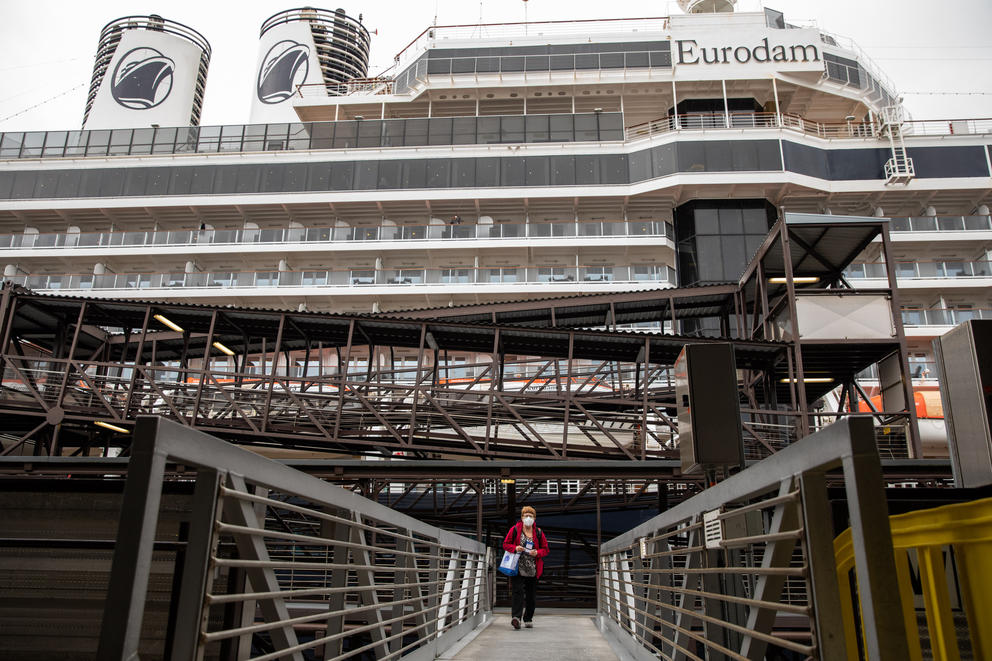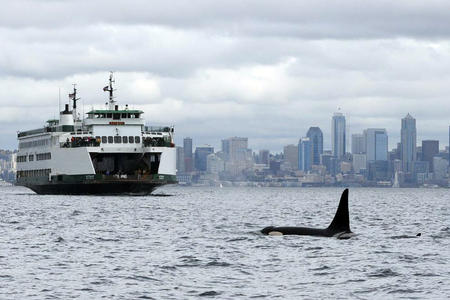“We don't always feel that way when we go back to work on Monday morning,” she said. “But people having been out of work for a year, plus you could just really feel the energy of those folks being thrilled on that beautiful morning to tie that ship up.”
This story is part of a Crosscut focus on tourism: Open for Visitors.
Amid a series of sudden and debilitating COVID-19 outbreaks on cruise ships across the U.S. and beyond, with the CDC issuing a no-sail order in March 2020, the cruise industry in this Pacific Northwest region drifted to a standstill for the first time since the city’s Bell Street cruise terminal opened in 1996 at Pier 66.
Now, after months of the Port of Seattle officials’ behind-the-scenes work adding COVID safety measures in the terminals — from touchless water-bottle filling stations and barriers to cutbacks on face-to-face interaction and a hospital-grade ventilation system —Jones Stebbins took in the excitement of the arrival of Serenade of the Seas.
Nine months later, the Puget Sound cruise industry started its 2022 season at its traditional time in the spring, with agreements among the Port of Seattle, cruise lines and local health departments detailing COVID protocols (which included having at least 95% of vaccine-eligible passengers and crew vaccinated and isolation and disembarkation procedures following a COVID outbreak).
Whether because the public has confidence in the safety measures or simply is eager to get back to cruising after such a long wait, the port expects more passengers and ships than the pre-COVID 2019 season.
While they’re anticipating that ships will keep their passenger numbers at about three-fourths capacity to help ward off the virus, the Port of Seattle expects to see 1.26 million passengers and 296 sailings this year – thousands more passengers and dozens more sailings than in 2019.
But, as Jones Stebbins put it, “there’s new challenges every day.” And the latest involved a COVID outbreak on a cruise ship that docked in Seattle last month. Carnival Cruise Line did not respond to a request for comment.
The Centers for Disease Control and Prevention rated the outbreak orange, which meant that, on a ship with a 2,124-guest capacity and 930 crew members, 0.3% or more tested positive.
The pandemic also spelled the end for adding a third cruise terminal at Pier 46 in Seattle. Ryan Calkins, a Port of Seattle Commissioner, said the port had put out a request for proposals for a new cruise ship berth, but “in light of COVID [we] had retracted that and at this point, there’s no plans to reissue an RFP for cruise use at 46.”
The port is now in discussions about using the terminal predominantly for cargo ships.
Meanwhile, concerns and protests have been raised over whether this return to business-as-usual for the cruise industry was less an accomplishment than a wasted opportunity.
Stacy Oaks, founding member of Seattle Cruise Control, a group working to end cruising in the Salish Sea, said that during the pause she had hoped local officials would drastically change how the area does cruising given its negative impacts on the environment.
“We had that opportunity to really rethink, is this what we want to be doing,” she said. “And, unfortunately, when they came back, it was full celebration mode. And so I think there was a missed opportunity there.”
Between greenhouse-gas emissions from each vessel and the flights passengers take into Seattle before and after cruises, Oaks believes removing the cruise industry could eliminate as much as one-third of Seattle’s carbon emissions.
“We do want to see a cruise-free Salish Sea,” she said. “We also know that that's a transition that would need to happen. But the first step is admitting that there's a problem. And the next step is starting to take real bold action as much as actually can be done legally on that journey.”
Oaks would like to see changes such as preferential docking for companies with better environmental practices, refusing those cruise companies that repeatedly pollute and adding fees to cruising that could help fund restoration projects.
Asked how the port is responding to the environmental impacts of cruising, Calkins highlighted the fact that the port has been working toward adding electric shore power to Pier 66 (Terminal 91 already has it) so ships can turn off their diesel engines while docked. The addition is expected by 2024.
But Calkins estimated that ships are in port, plugged in, only about 4% of the time. And not all cruise ships are equipped to use shore power. In 2021, for example, 53 cruise ships docked at terminal 91, but only 30 actually used shore power.
In 2020 the port committed to phasing out emissions associated with seaport activities by 2050. And in May it announced its partnership with Juneau, Alaska; the Port of Vancouver; British Columbia; and several cruise lines to potentially launch the world’s first green cruise corridor — a maritime route without greenhouse-gas emissions.
Calkins also referenced the broader effort around hydrogen-powered cruise ships, as well as ammonia and methanol fuels for ships, saying he would like to see these used in the near future for vessels docking in Seattle.
“I am excited to see that the technology is not science fiction any longer,” he said. “It's actually possible and work is happening around the world right now to bring it to bear on both shipping and the cruise industry.”
The economic impact of the cruise industry is also an important factor in cruising’s impact on Seattle, which was made especially clear during the months-long pause. From local employees on the dock to the array of locally sourced foods on the ships (including Darigold dairy products and wine from Eastern Washington) and the money passengers spend on shore before or after a cruise, Jones Stebbins said each ship visit translates into about $4.2 million for the local economy.
While the industry was down, the local economy saw an estimated loss of $900 million.
Jones Stebbins said that with the industry fully restarted, they’re making sure each cruise call has an increasingly large impact on the economy. Several years ago they added the port valet program, which allows passengers getting off a cruise ship and catching a flight out of Seattle later in the day to send their bags straight to their destination. That way they can spend more time shopping in Seattle.
This year they also launched a series of job fairs in an effort to help more young people take advantage of the estimated 5,500 local jobs associated with the maritime community and cruise industry.
Jones Stebbins said that when looking at the best path forward for the industry, it shouldn’t be about removing this key part of the local economy, but rather leading toward operating the industry without harmful emissions.
“I feel as an environmentalist, I feel very optimistic about our biggest opportunity to really move towards decarbonization leadership in areas that also preserve people's ability to support their families,” she said. “As an economic development agency, we need to do both at the same time.”










